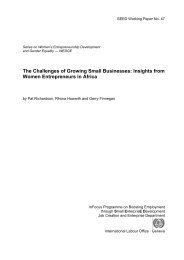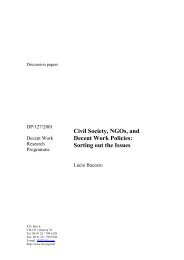Nepal Trafficking in Girls With Special Reference to Prostitution: A ...
Nepal Trafficking in Girls With Special Reference to Prostitution: A ...
Nepal Trafficking in Girls With Special Reference to Prostitution: A ...
Create successful ePaper yourself
Turn your PDF publications into a flip-book with our unique Google optimized e-Paper software.
A Rapid Assessment<br />
Executive Summary tion consists of both quantitative and qualitative data<br />
that has been generated through <strong>in</strong>terviews and field<br />
Background<br />
The exploitative practice of child labour has come<br />
<strong>to</strong> be recognized as a major socio-economic problem.<br />
Child labour jeopardizes children’s potential <strong>to</strong><br />
become productive adults, robb<strong>in</strong>g them of their<br />
health, their education and their prospects for a better<br />
future. It is an affront <strong>to</strong> the pr<strong>in</strong>ciples of social justice,<br />
child rights and <strong>to</strong> the protection of human rights.<br />
Children are among the most neglected, abused and<br />
exploited segments of the population, exposed <strong>to</strong> such<br />
worst forms of labour as traffick<strong>in</strong>g for sexual exploitation.<br />
The need <strong>to</strong> restrict and eradicate such <strong>in</strong><strong>to</strong>lerable<br />
forms of child labour has become an essential<br />
element of a national development strategy <strong>to</strong> achieve<br />
susta<strong>in</strong>able growth and protect human rights. His<br />
Majesty’s Government of <strong>Nepal</strong> (HMG/N) has repeatedly<br />
expressed its commitment <strong>to</strong> elim<strong>in</strong>at<strong>in</strong>g the<br />
worst forms of child labour, and the government is<br />
currently <strong>in</strong> the process of ratify<strong>in</strong>g the new ILO Convention<br />
on the Worst Forms of Child Labour, No. 182.<br />
This Rapid Assessment aims <strong>to</strong> shed new light<br />
on the plight and lives of <strong>Nepal</strong>ese girls trafficked<br />
with<strong>in</strong> their country or across the border <strong>to</strong> India, for<br />
sexual exploitation. The f<strong>in</strong>d<strong>in</strong>gs of this study will<br />
help complete the vast gaps <strong>in</strong> knowledge and <strong>in</strong>formation<br />
on this <strong>to</strong>pic, and thus provide <strong>in</strong>valuable background<br />
<strong>to</strong> future action programmes aimed at elim<strong>in</strong>at<strong>in</strong>g<br />
this worst form of child labour. More specifically,<br />
the study focuses on uncover<strong>in</strong>g the causes,<br />
characteristics, magnitude and consequences of these<br />
children and their <strong>in</strong>volvement <strong>in</strong> this hidden worst<br />
form, and <strong>to</strong> offer recommendations based on these<br />
f<strong>in</strong>d<strong>in</strong>gs.<br />
This study is based on the Rapid Assessment<br />
(RA) methodology developed by the International<br />
Labour Organization/ International Programme on the<br />
Elim<strong>in</strong>ation of Child Labour (ILO/IPEC) and the<br />
United Nations Children’s Fund (UNICEF). The Rapid<br />
Assessment comb<strong>in</strong>es both quantitative and qualitative<br />
data gather<strong>in</strong>g <strong>to</strong>ols, and is aimed at obta<strong>in</strong><strong>in</strong>g <strong>in</strong>depth<br />
knowledge of a given phenomenon with<strong>in</strong> only<br />
three months. Secondary <strong>in</strong>formation has been obta<strong>in</strong>ed<br />
from available sources such as reports, newspaper<br />
articles, and sem<strong>in</strong>ar papers. Primary <strong>in</strong>forma-<br />
surveys, with an emphasis on qualitative data that may<br />
shed light on the often hidden aspects of traffick<strong>in</strong>g<br />
for sexual exploitation.<br />
The populations targeted for <strong>in</strong>vestigation were<br />
vulnerable girls, and girls and women who had been<br />
trafficked for sexual exploitation, as well as girls engaged<br />
<strong>in</strong> prostitution <strong>in</strong> <strong>Nepal</strong> and trafficked girls liv<strong>in</strong>g<br />
<strong>in</strong> rehabilitation centres or who have been re<strong>in</strong>tegrated<br />
<strong>in</strong><strong>to</strong> their families, communities, and/or society,<br />
referred <strong>to</strong> as returnees.<br />
The researchers discovered that the world of traffick<strong>in</strong>g<br />
is characterized by fear and by vested political<br />
and economic <strong>in</strong>terests. The f<strong>in</strong>d<strong>in</strong>gs below illustrate<br />
this po<strong>in</strong>t repeatedly.<br />
Who is be<strong>in</strong>g trafficked?<br />
The study f<strong>in</strong>d<strong>in</strong>gs estimate that 12,000 children<br />
are trafficked every year from <strong>Nepal</strong>. The local his<strong>to</strong>ry<br />
implies that traffick<strong>in</strong>g has long been associated<br />
with poverty, social exclusion, and ignorance, as well<br />
as with the practice of slavery and the bonded labour<br />
system. <strong>Traffick<strong>in</strong>g</strong> crosses many caste/ethnic groups<br />
of <strong>Nepal</strong>, but most at risk are members of the hill ethnic<br />
group and lower castes. <strong>Traffick<strong>in</strong>g</strong> of girls seldom<br />
takes place before the onset of puberty, about<br />
age thirteen; about one quarter of the study sample<br />
was trafficked when under the age of 14, and more<br />
than half were under 16.<br />
How are they be<strong>in</strong>g trafficked?<br />
The complex process of traffick<strong>in</strong>g can be expla<strong>in</strong>ed<br />
by two models (as developed by John<br />
Fredericks), “hard” and “soft.” The former is conducted<br />
through force and false promises. It spreads<br />
from one district <strong>to</strong> another and has largely shifted<br />
from rural <strong>to</strong> urban areas.<br />
The dist<strong>in</strong>ction between soft and hard traffick<strong>in</strong>g refers<br />
<strong>to</strong> coercion and/or complicity of members of a nuclear<br />
family and/or extended family <strong>in</strong> the entry of a person <strong>in</strong><strong>to</strong><br />
forced or under-aged prostitution. It does not refer <strong>to</strong> pattern<br />
of movement or <strong>to</strong> roles played. In soft traffick<strong>in</strong>g, nuclear<br />
and/or extended family members can play roles besides<br />
‘seller,’ <strong>in</strong>clud<strong>in</strong>g transporter and purchaser (if the person is<br />
sent <strong>to</strong> work <strong>in</strong> a family-owned establishment).<br />
1

















